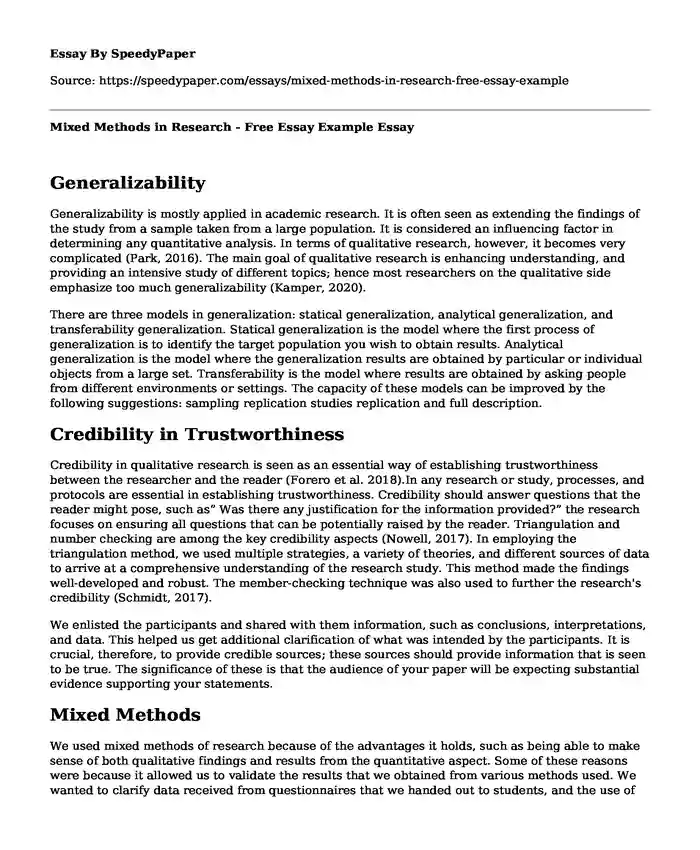Generalizability
Generalizability is mostly applied in academic research. It is often seen as extending the findings of the study from a sample taken from a large population. It is considered an influencing factor in determining any quantitative analysis. In terms of qualitative research, however, it becomes very complicated (Park, 2016). The main goal of qualitative research is enhancing understanding, and providing an intensive study of different topics; hence most researchers on the qualitative side emphasize too much generalizability (Kamper, 2020).
There are three models in generalization: statical generalization, analytical generalization, and transferability generalization. Statical generalization is the model where the first process of generalization is to identify the target population you wish to obtain results. Analytical generalization is the model where the generalization results are obtained by particular or individual objects from a large set. Transferability is the model where results are obtained by asking people from different environments or settings. The capacity of these models can be improved by the following suggestions: sampling replication studies replication and full description.
Credibility in Trustworthiness
Credibility in qualitative research is seen as an essential way of establishing trustworthiness between the researcher and the reader (Forero et al. 2018).In any research or study, processes, and protocols are essential in establishing trustworthiness. Credibility should answer questions that the reader might pose, such as” Was there any justification for the information provided?” the research focuses on ensuring all questions that can be potentially raised by the reader. Triangulation and number checking are among the key credibility aspects (Nowell, 2017). In employing the triangulation method, we used multiple strategies, a variety of theories, and different sources of data to arrive at a comprehensive understanding of the research study. This method made the findings well-developed and robust. The member-checking technique was also used to further the research's credibility (Schmidt, 2017).
We enlisted the participants and shared with them information, such as conclusions, interpretations, and data. This helped us get additional clarification of what was intended by the participants. It is crucial, therefore, to provide credible sources; these sources should provide information that is seen to be true. The significance of these is that the audience of your paper will be expecting substantial evidence supporting your statements.
Mixed Methods
We used mixed methods of research because of the advantages it holds, such as being able to make sense of both qualitative findings and results from the quantitative aspect. Some of these reasons were because it allowed us to validate the results that we obtained from various methods used. We wanted to clarify data received from questionnaires that we handed out to students, and the use of mixed methods helped us to clear out any contradictions in the feedback received (McKim, 2017).
In the quantitative approach, we employed generalizability. We achieved this through sampling strategies such as stratified sampling, conceptualization, and systematic reviews, among others, in the dissertation (Elo, 2014).
The methods applied in the qualitative aspect were strategies such as triangulation and member checking to provide a more in-depth insight into the topic of research. This was achieved through enlisting participants and groups and having direct interaction with them, hence helping in achieving credible results. In the dissertation, the researcher was instrumental, and the participants contributed to the data collection, interpretation, and final analysis (Cutcliffe, 1999)
Employing mixed-method also provided some challenges such as it was time-consuming. It required expertise in integrating both the qualitative and quantitative aspects. It consumed most of our resources to try and implement in the field. This, in turn, made the research process very complicated. Through the adoption of these mixed methods in research, we gave a voice to the participants and collected rich and credible data.
References
Assarroudi, A., Heshmati Nabavi, F., Armat, M. R., Ebadi, A., & Vaismoradi, M. (2018). Directed qualitative content analysis: The description and elaboration of its underpinning methods and data analysis process. Journal of Research in Nursing, 23(1). https://journals.sagepub.com/doi/abs/10.1177/1744987117741667
Cutcliffe, J. R. (1999). Establishing the credibility of qualitative research findings: the plot thickens. Journal of advanced nursing, 30(2), 374-380. https://onlinelibrary.wiley.com/doi/abs/10.1046/j.1365-2648.1999.01090.x
Elo, S. (2014). Qualitative content analysis: A focus on trustworthiness. SAGE Open, 4(1), 2158244014522633. https://journals.sagepub.com/doi/abs/10.1177/2158244014522633
Forero, R., Nahidi, S., De Costa, J., Mohsin, M., Fitzgerald, G., Gibson, N, & Aboagye-Sarfo, P. (2018). Application of four-dimension criteria to assess the rigor of qualitative research in emergency medicine. BMC Health Services Research, 18(1), 120. https://link.springer.com/article/10.1186/s12913-018-2915-2
Kamper, S. J. (2020). Generalizability: Linking evidence to practice. Journal of orthopedic & sports physical therapy, 50(1), 45-46. https://www.jospt.org/doi/abs/10.2519/jospt.2020.0701
McKim, C. A. (2017). The value of mixed methods research: A mixed-methods study. Journal of Mixed Methods Research, 11(2), 202-222. https://journals.sagepub.com/doi/abs/10.1177/1558689815607096
Nowell, L. S., Norris, J. M., White, D. E., & Moules, N. J. (2017). Thematic analysis: Striving to meet the trustworthiness criteria. International journal of qualitative methods, 16(1), 1609406917733847. https://journals.sagepub.com/doi/abs/10.1177/1609406917733847
Park, J., & Park, M. (2016). Qualitative versus quantitative research methods: Discovery or justification?. Journal of Marketing Thought, 3(1), 1-8. http://www.papersearch.net/thesis/article.asp?key=3560136
Schmidt, F. L. (2017). Beyond questionable research methods: The role of omitted relevant research in the credibility of the study. Archives of Scientific Psychology, 5(1), 32. https://psycnet.apa.org/doiLanding?doi=10.1037/arc0000033
Xu, B. (2019). Stratified random sampling from streaming and stored data. In Electrical and Computer Engineering Conference Papers, Posters and Presentations. http://penguin.ewu.edu/~bojianxu/publications/sss-edbt-2019.pdf
Cite this page
Mixed Methods in Research - Free Essay Example. (2023, Nov 12). Retrieved from https://speedypaper.com/essays/mixed-methods-in-research-free-essay-example
Request Removal
If you are the original author of this essay and no longer wish to have it published on the SpeedyPaper website, please click below to request its removal:
- Research Paper Sample on Arabic as a Second Language
- Essay Sample for Free: Charter Schools in the United States of America
- Statistics Paper Example with Questions on T-Test
- Essay Example: Internal Analysis for Cathay Pacific Airways Essay
- Situational Awareness of Speeding. Free Essay
- Free Essay: Anonymous Survey on Confinement during the COVID-19 Pandemic
- Statistical Analysis and Data Interpretation - Free Essay Sample
Popular categories





